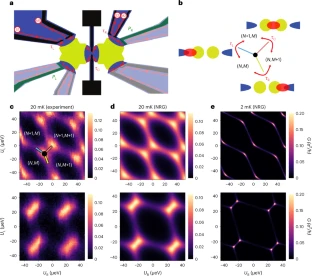Phys.org January 30, 2023
Tuning a material to the cusp between two distinct ground states can produce physical properties that are unlike those in either of the neighbouring phases. A tunable array of coupled qubits should have an appropriately rich phase diagram but realizing such a system with either tunnel-coupled semiconductor quantum dots or metal nanostructures has proven difficult. The challenge for scaling up to clusters or lattices is to ensure that each element behaves essentially identically and that the coupling between elements is uniform, while also maintaining tunability of the interactions. Advances in the fabrication and control of quantum systems have raised the tantalizing prospect of artificial quantum simulators that can capture such behaviour. An international team of researchers (USA – Stanford University, SLAC National Accelerator Laboratory, MIT, France, Ireland) studied a nanoelectronic circuit comprising two coupled hybrid metal–semiconductor islands and combined the strengths of both materials to form a potentially scalable platform. The semiconductor component allowed for controllable inter-site couplings at quantum point contacts, while the metal component’s effective continuum of states meant that different sites could be made equivalent by tuning local potentials. According to the researchers the couplings afforded by this architecture could realize an unusual quantum critical point resulting from frustrated Kondo interactions. The observed critical behaviour matched theoretical predictions, verifying the success of their experimental quantum simulation…read more. TECHNICAL ARTICLE

Two-island charge Kondo device. CREDIT: Nature Physics (2023)